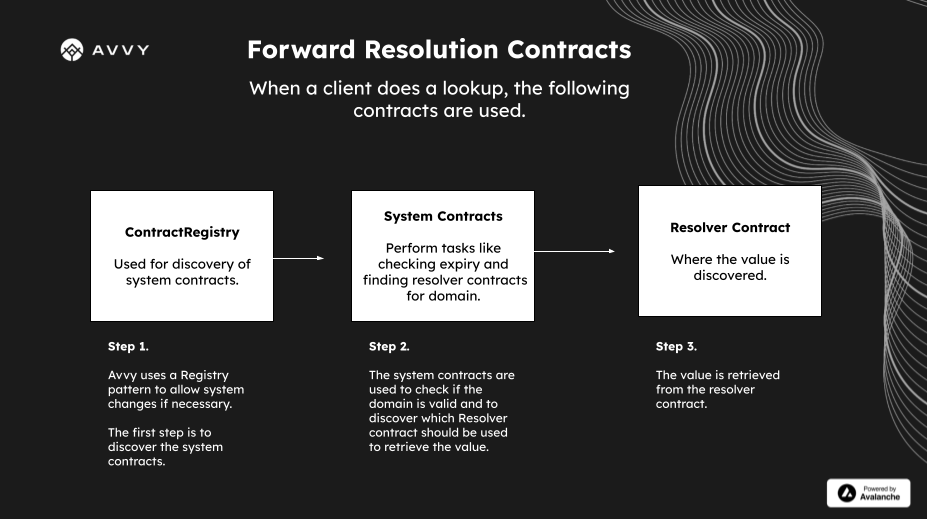#
Forward Resolution Checks
When we want to resolve a value from a .avax domain, we need to be aware that there are many factors that can change which value a domain resolves to.
Developers integrating the Avvy Domains system may want to be aware of the following situations where a value could change, and further how we can detect those changes.
#
What happens during forward resolution?
The following diagram explains which contracts are used during forward resolution:

#
Where can things change?
As a security precaution, projects may want to display alerts for users when values which impact forward resolution have been changed.
#
1) ContractRegistry changes
The Avvy system supports logic changes using a Registry pattern. Contract addresses are discovered via a Registry.
The ContractRegistry address is 0x4832D668C2c75Fa10C597FD19B116d2E1873ED69. When a contract reference is set in the ContractRegistry it will emit a Set(string contractName, address contractAddress) event.
Contract references that may be used during resolution are:
Domain(the main ERC721 representing the domains)ResolverRegistry(keeps track of whichResolvercontracts should be used for resolving domains)NameHash(utility contract used to convert a plaintext name into an ID in the system)
Projects can monitor events emitted by the ContractRegistry to determine when and how the Avvy Domains system has been updated.
#
2) ResolverRegistry changes
The ResolverRegistry is used to discover the contract which should be used to look up a value for a domain name. The holder of a domain can make changes to the ResolverRegistry.
The ResolverRegistry address is 0x3947d4c62C108A8A7bA3ED53AbaDcFF5D8998637. When a Resolver is set for a given domain, a ResolverSet event is fired. Projects can monitor events emitted by the ResolverRegistry to determine when resolvers have been updated.
#
3) Resolver changes
Resolvers are recommended to emit the following events when resolution values change:
event StandardEntrySet(uint256 indexed datasetId, uint256 indexed hash, uint256[] path, uint256 key, string data);
event EntrySet(uint256 indexed datasetId, uint256 indexed hash, uint256[] path, string key, string data);Custom resolvers can be implemented, so it is possible that some will not implement this interface.
StandardEntrySet events with key=3 would represent changes to the EVM address that resolves.